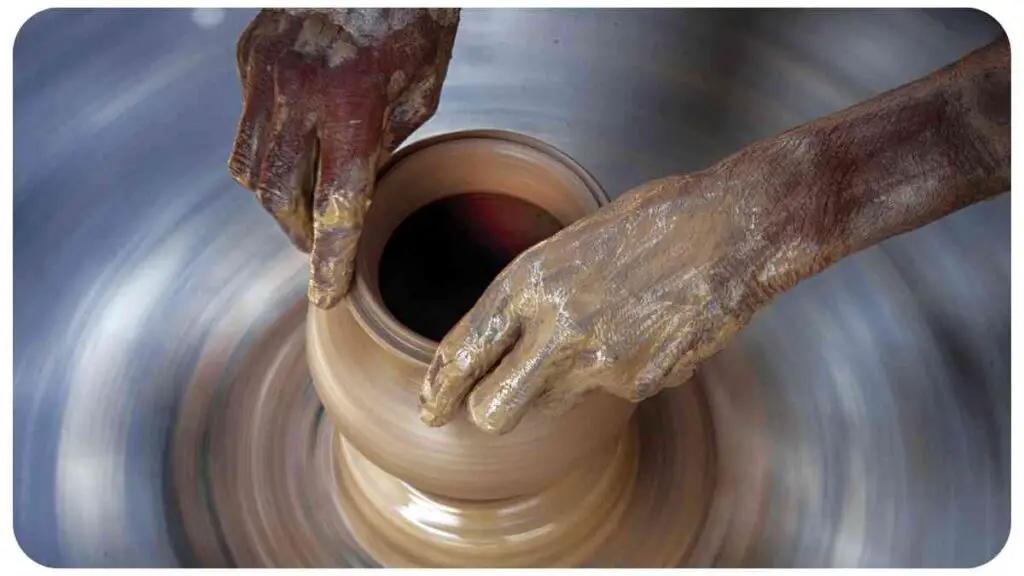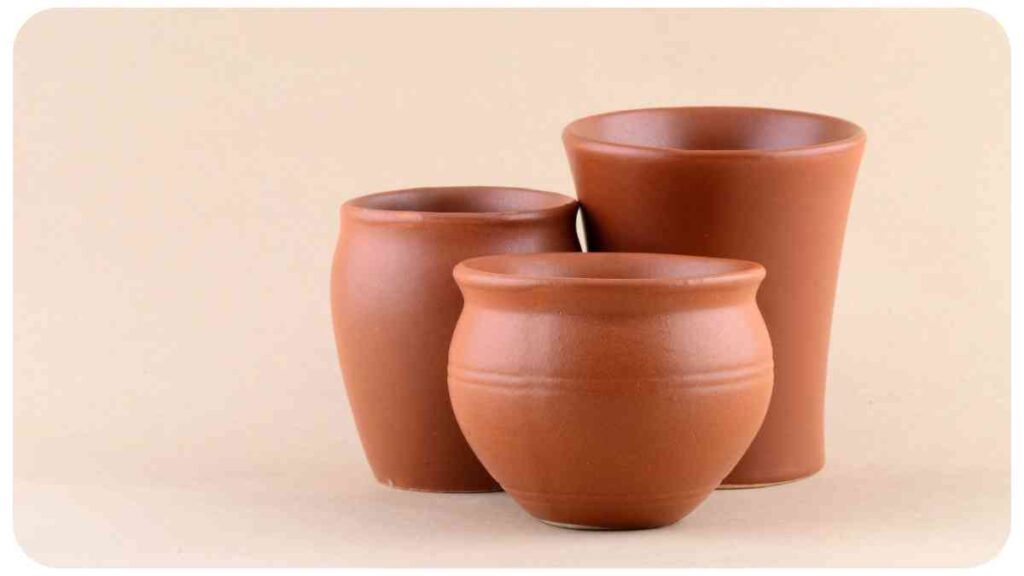As a pottery enthusiast, there’s nothing quite as frustrating as working with lumpy clay. Whether you’re a beginner or an experienced ceramic artist, dealing with lumpy clay can derail your pottery-making process. But fear not! In this article, we will dive into the world of lumpy clay, offering expert advice and techniques to get your pottery back on track.
By adhering to the following steps and tips, you’ll be able to resolve lumpy clay issues and create beautiful, smooth pottery in no time.
| Key Takeaways |
|---|
| – Understanding the causes of lumpy clay is crucial for effective troubleshooting and salvage. |
| – Kneading and wedging clay are essential steps to recondition lumpy clay and improve workability. |
| – Adjusting moisture levels using techniques like spritzing and wrapping can help restore clay consistency. |
| – Utilizing clay additives and sieving techniques can further enhance clay workability and remove impurities. |
| – Proper storage, consistent moisture maintenance, and regular clay maintenance routines can prevent lumpy clay issues. |
| – Troubleshooting common pottery problems, such as cracking and surface imperfections, requires specific techniques. |
| – Exploring additional resources on primitive pottery, wire wedging, and glaze management can provide further insights. |
Understanding Clay Consistency
Before we delve into troubleshooting lumpy clay, it’s essential to understand the characteristics of ideal clay and how to identify lumpy clay. Clay consistency plays a vital role in the quality of your pottery. Ideal clay should be smooth, pliable, and free from lumps and air pockets.
When lumps are present, they can compromise the structure and surface finish of your ceramic pieces. Identifying lumpy clay is crucial in order to address the issue effectively.
Building a collection of scrapbooking supplies is essential for any enthusiast. Check out our guide on choosing the right scrapbooking supplies to create amazing projects.
Troubleshooting Lumpy Clay
Lumpy clay can be caused by various factors, and each requires specific techniques to salvage the clay. Common causes of lumps include improper storage, inadequate moisture control, and contamination.
By understanding the root causes, you’ll be better equipped to tackle lumpy clay effectively. In this section, we will outline these causes and provide techniques to troubleshoot and salvage your clay.
Techniques for Getting Pottery Back on Track

Getting your pottery back on track requires specific techniques to recondition the clay. Throughout this section, we will guide you through essential methods such as kneading and wedging clay, adjusting moisture levels, and utilizing clay additives.
These techniques will help smooth out lumpy clay, making it workable and ready for your creative endeavors.
Get creative and express your emotions through handmade cards. Learn the best techniques in our ultimate guide to card making tips and tricks for endless inspiration.
Tools and Equipment for Working with Clay
Table 1: Essential Tools and Equipment for Working with Clay
| Tools & Equipment | Usage |
| Clay wedging table | Provides a stable surface for kneading and wedging clay |
| Clay roller and slab cutter | Creates flat and consistent clay slabs for pottery construction |
| Clay extruder and pugmill | Facilitates clay conditioning and reclaiming processes |
Having the right tools and equipment is important for handling and reconditioning lumpy clay effectively. Refer to Table 1 for a list of essential tools and equipment when working with clay.
Step-by-Step Process for Dealing with Lumpy Clay
Preparing your workspace
Before working with lumpy clay, it’s crucial to have a clean and organized workspace. Clear your work area and gather all the necessary tools and materials. This will enable you to focus on the clay reconditioning process without any distractions.
Assessing the clay condition
Take a close look at your lumpy clay and determine its moisture content. Dry or stiff clay requires different techniques compared to overly moist clay. Understanding the condition of your clay will help you choose the appropriate reconditioning method.
Discover the beauty of origami and create intricate paper designs. Follow our step-by-step guide for origami beginners to learn impressive folding techniques.
Kneading and wedging the clay
Properly kneading and wedging clay is an essential step to resolve lumpy clay issues. Kneading helps to distribute moisture evenly and eliminate air
Table 2: Common Pottery Problems and Troubleshooting Techniques
| Pottery Problem | Troubleshooting Technique |
| Cracking and warping | Proper drying and bisque firing techniques |
| Surface imperfections | Sanding, smoothing, and glazing techniques |
| Air bubbles | Slowing down the throwing process, needle tool for de-airing clay |
Adjusting moisture levels
Table 3: Clay Moisture Adjustment Techniques
| Technique | Description |
| Spritzing | Spraying water to add moisture to dry or stiff clay |
| Wrapping | Using plastic wrap or damp cloth to retain moisture in clay |
| Drying | Air-drying clay to decrease moisture content |
Using clay additives and sieving techniques

Table 4: Clay Additives and Their Effects
| Additive | Effect on Clay |
| Deflocculant | Increases clay workability |
| Bentonite | Enhances plasticity |
| Grog | Adds textural and structural stability |
Sieving clay is an effective technique to remove impurities and lumps. Table 5 showcases some commonly used sieves for clay processing.
Table 5: Clay Sieves
| Sieve Size (mesh) | Recommended Usage |
| 80 | Removing large particles and impurities from clay |
| 120 | Smoothing clay and removing medium-sized impurities |
| 200 | Refining clay to remove fine particles and lumps |
Tips to Prevent Lumpy Clay Issues
To minimize lumpy clay occurrences in the future, follow these practical tips:
- Proper clay storage: Store your clay in a cool and damp environment to maintain its moisture content and prevent drying or excessive absorption of moisture.
- Consistent moisture maintenance: Regularly check the moisture content of your clay and adjust it accordingly using appropriate techniques.
- Establishing a regular clay maintenance routine: Develop a habit of wedging and kneading your clay before every pottery session to ensure its workability and eliminate potential lumps.
Dive into the history and evolution of acrylic paint as an art medium. Explore our article on the evolution of acrylic paint: a look back in time to gain a deeper understanding of this versatile medium.
Conclusion
Dealing with lumpy clay can be a frustrating setback in the pottery-making process. However, armed with the knowledge and techniques outlined in this article, you now have the expertise to get your pottery back on track.
By understanding the causes of lumpy clay and utilizing the appropriate troubleshooting techniques, you can salvage and recondition your clay effectively. Remember to use the right tools, adjust moisture levels, and incorporate additives when necessary. By implementing regular clay maintenance practices and following the provided tips, you can prevent lumpy clay issues in the future. Happy potting!
Pottery is a beautiful art form that requires patience and skill. Start your journey with our DIY pottery tips and tricks for beginners, and unlock your creative potential with clay.
Further Reading
For more information on pottery techniques, troubleshooting, and studio management, consider exploring the following resources:
Primitive Pottery: A Complete Guide This comprehensive guide provides insights into the world of primitive pottery, covering various techniques, tools, and materials used throughout history. It offers a deeper understanding of pottery traditions and their significance.
Stack and Slam: Wire Wedging – An Efficient and Easy-on-the-Wrists Way to Wedge Pottery Clay This article from Ceramic Arts Network explores a specific wedging technique called “Stack and Slam.” It provides detailed instructions on how to utilize this efficient method for wedging pottery clay, reducing strain on the wrists.
12 Tips for Managing Glazes at a Busy Pottery Studio If you’re interested in managing glazes in a busy pottery studio, this article by Sue McLeod Ceramics offers valuable tips and advice. From organization strategies to maintaining consistent glaze quality, these tips will help streamline your studio workflow.
FAQs
Here are some frequently asked questions related to dealing with lumpy clay and getting pottery back on track:
How can I prevent lumpy clay in the first place?
To prevent lumpy clay, ensure proper clay storage in a cool and damp place, maintain consistent moisture levels, and knead and wedge the clay before each pottery session.
What should I do if I encounter small lumps while working on a piece?
If you encounter small lumps while working, you can gently smooth them out with your fingers or use a small tool to remove them. Avoid applying excessive pressure as it may distort your piece.
Can I reuse clay that has already been fired?
Once clay has been fired, it becomes ceramic and cannot be rehydrated or reused as clay. However, you can repurpose fired ceramic pieces through methods like grinding them into ceramic grog or incorporating them into new clay bodies.
How can I prevent my pottery from cracking during drying and firing?
To prevent cracking, ensure even drying by allowing your pottery to dry slowly and evenly. Avoid drying too quickly, especially in areas with thicker walls or high moisture content. Additionally, follow appropriate firing cycles and avoid sudden temperature changes during firing.
What are some tips for glazing pottery effectively?
When glazing pottery, make sure your pieces are clean and free from dust or debris. Apply glaze evenly and carefully, using multiple coats if needed. Follow the recommended firing temperature and duration for your chosen glaze, and consider experimenting with different glaze application techniques to achieve desired results.

Hellen James is the creator of Unified Crafts and has been crafting since she was a kid accompanied by her mom to the craft store, where she was free to choose whatever ignited her imagination.

